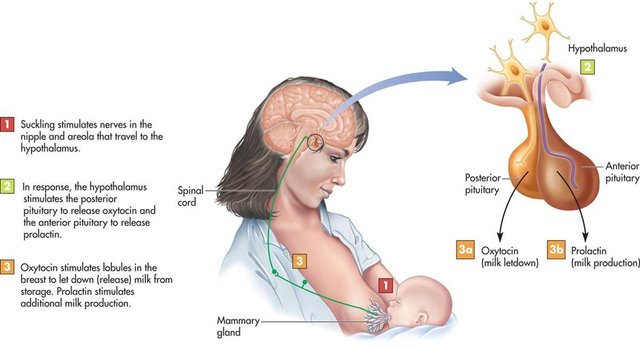MystiFACT-or-FICTION response #1 – Orgasmic oxytocin
Oxytocin is best known as the ‘love hormone’. Despite this, there are many other, less well known, effects that oxytocin has on the body which I will be discussing in this article.

Figure 1. oxytocin
Oxytocin is a neurotransmitter in the brain, and can act as a hormone. It has many roles in pair bonding, relationships and social interactions. It is released during sex, while giving birth and during a hug.
Oxytocin is also released in a positive feedback loop during breastfeeding. When the infant begins to suckle, oxytocin triggers the ejection of milk from a mother’s breast in order to feed her child. This occurs because the suckling of the baby at the nipple is detected and a signal is relayed by spinal nerves to the hypothalamus. This stimulation causes neurones to synthesise oxytocin in the paraventricular nucleus of the hypothalamus and consequently release oxytocin from the posterior pituitary gland in recurrent bursts. These bursts of oxytocin correspond to the secretion of milk.

Figure 2. mechanism of oxytocin release during breastfeeding
In addition to this, oxytocin is released during an orgasm and unusual effects can occur if this is combined with a recent mother who is still breastfeeding her child. Since oxytocin is released during an orgasm, but also during lactation, when a mother (who is also breastfeeding) has an orgasm the sudden surge of oxytocin will simultaneously trigger the ejection of milk from her nipples.
This will cause the woman to eject milk upon orgasm!
But hold on, the oxytocin wouldn’t have an affect on breastfeeding if it is released in response to an orgasm would it?
The answer is, yes, of course it would. Unlike nervous responses to stimuli, which are very specific, hormones respond in a much more global manner across the entire body. As the oxytocin is released in response to an orgasm, it is circulated in the blood (like all hormones are). This means to have intracellular effects, oxytocin must bind to various receptors on the surface of cells. The way in which hormones like oxytocin bring about their effects is via these receptors, which have different intracellular responses. Each cell that is responsive to oxytocin will have a different receptor type. When oxytocin binds to these receptors, each cell will have a different effect depending on the cell type. Thus, in breast cells oxytocin binding to the receptor will produce lactation, but in other cells it will have different effects which will depend on the specific receptor that oxytocin binds to.
The ejection of milk from a mother during orgasm is an effect that results from the many roles of oxytocin throughout the body and the non-specific nature with which hormones act.
References:
Figure 1
Figure 2
https://www.ncbi.nlm.nih.gov/pmc/articles/PMC3183515/
https://en.wikipedia.org/wiki/Oxytocin
Useful info
Thank you for entering my challenge. Great article; now I know when to stay away from my future wife! Best of luck with the results :)
Ahahahahaha thank you. At least you will know if she's faking.
Oxytocin is affected by the galvanic skin response and other stressor responses. Even to sodium. Oxytocin is usually only known for its positive bonding action however it should be seen more as a learning hormone as it controls the fear response as well. The love hormone(peptide) is B-PEA
https://www.ncbi.nlm.nih.gov/pmc/articles/PMC4748433/
I agree that PEA may be involved in love as well as oxytocin and it is not as simple as just saying that one single chemical is entirely responsible for the single and very complex emotion that is love. Historically oxytocin is known as the 'love hormone' whether it is actually directly involved in love is another matter. Additionally I was under the impression that PEA acts more as a neurotransmitter in the brain rather than a hormone in the bloodstream like oxytocin. Of course oxytocin has many effects not just in sex and relationships. But as one of its effects is to increase phenethylamines like you suggest then it can be seen as being involved in love.
I would love to hear your response to this and thank you for informing me more about the effects of PEA.
True that PEA is not generally classified as a hormone. It is a neuropeptide. Oxytocin is better classified as the connection hormone as it increases associations from both desireable and indesireable stimulation. Its classification as the love hormone ignores its role in fear conditioning. Without PEA's involvement, oxytocin would not effectively elicit a "love" deep rewarding association, more that of meh-like at best
Thank you for clarifying, as I touched upon in my article, oxytocin has a wide array of effects. I personally did not give the name 'love hormone' to oxytocin, it is simply what the hormone has become known as to many people as a sort of nickname. I agree that labelling if the love hormone does overlook the other aspects of the hormone and without PEA oxytocin would not elicit a feeling of love. That being said, oxytocin does cause some feeling associated with love which is how it got its nickname. Perhaps it is known as the 'love hormone' becasue it activates PEA.
Forgive me, I believe I was mistaken, oxytocin does not seem to influence phenethylamine levels as I had thought I remembered. Oxytocin is coinervated with dopamine however phenethylamine allows for the buildup of said dopamine. Which in turn I would think enhance oxytocin as well. For a moment I had thought oxytocin to similarly modulate dopamine reuptake.
Congratulations @ovij! You have completed some achievement on Steemit and have been rewarded with new badge(s) :
Click on any badge to view your own Board of Honor on SteemitBoard.
For more information about SteemitBoard, click here
If you no longer want to receive notifications, reply to this comment with the word
STOPHmmm!
Informative